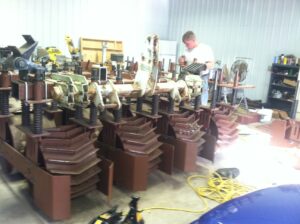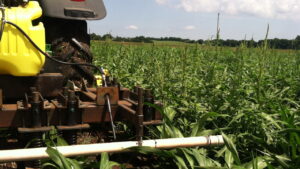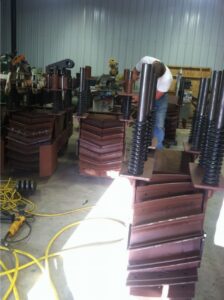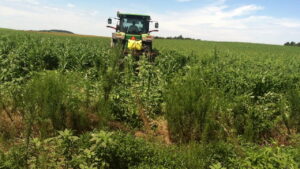Final Report for FNC16-1039
Project Information

I have spent many hours in the shop fabricating/building the rolling implement project. At present, I have constructed what I feel is a good start on a prototype of my proposed implement. For the first prototype, I started with 3 sets of two in-line wheels, the front built with a chevron design crushing bars, the second smooth to mash and also apply herbicide directly to the macerated weed. I was able to use this prototype to make a trial run through about 25 acres of Milo; the crop was matured to approximately a 30-inch stand. For my first run-through, I felt I needed to do a little re-designing but, overall was pleased with the success' that I had. My plan is to finish the machine with 7 sets of wheels to easily move through a 30 row crop. I have also fashioned it with lift assist wheels, my theory was to relieve the weight on the tractor's 3-point hitch lift assembly. I thought this would also allow a smoother turning process.

Roller implement in Milo field showing the wicker bar. Note in the photo, you will see tall, problematic weeds that many farmers are trying to manage in no-till row crop. Our objective was to build a mechanical implement that would crush and kill herbicide resistant weeds without tilling the ground in no-till row crop. The target for us is to combat the crop-choking weeds farmers are fighting, such as pigweed, palmer amaranth and other tall weeds that can take over a crop. We were able to do a trial run in a Milo field with the prototype and found it to be effective using the theory of first crimping, then crushing the weeds and following with the application of herbicide. Applying the herbicide directly onto the crushed weeds between rows and also the hitting the taller weeds within the row with the wicker bar.
Research
 Crimpers in a chevron pattern were built on the front set of rollers. This design worked well knocking down the large weeds and crimping them. Large weeds, some as tall as 4 or 5 feet were successfully knocked down and crimped flat in the row. We observed that after one pass with the crimper crusher and application of Corner Stone/Roundup in the the wicker, the weeds dried out and died quickly.
Crimpers in a chevron pattern were built on the front set of rollers. This design worked well knocking down the large weeds and crimping them. Large weeds, some as tall as 4 or 5 feet were successfully knocked down and crimped flat in the row. We observed that after one pass with the crimper crusher and application of Corner Stone/Roundup in the the wicker, the weeds dried out and died quickly.
My second prototype has so far, accomplished the desired effect in managing problem weeds. I feel this prototype has already seen success in the early stages of development.
Impact of Results/Outcomes
 .
.
After scrapping my first set of roller wheels, I built a new set of rollers that are 18 inches wide, this gave me approximately 9 inches of clearance for the mature crops. This has shown better results traveling through the field and allows more maneuverability between rows and far less damage to to the crop. I set my trial run through 25 acres of Milo crop, matured at the height of about 30 inches. The problem weeds were sometimes 4 to 5 ft tall. The implement was quite successful in crimping/crushing and laying down tall weeds between the row crop, also leaving the Milo crop stalks intact and without damage. With the roller widths changed to 18 inches, the side plates were moved in 2 3/16 inches to allow about 9 inches between rows. Covered plated were installed to keep weeds out of the shaft and bearing area and to help guide the crop stalk between roller. Springs were added to the roller brackets and these helped the roller run independently when I encountered uneven soil in the field.
My first prototype was designed using 1 inch thick steel for many of the components and mounting brackets. The implement was very rigid and when I encountered uneven soil buildup in the field, it would lift the machine up, causing not all of the rollers to contact the ground. I found this problematic. So, I designed and built my second prototype using 1/2 inch steel for most of the components and 1/4 inch steel plate for the side pieces. This lightened the weight of the machine significantly and a set of lift-assist wheels were also installed. This change in design helped keep the machine more agile when turning and lifting. This also took a lot of stress off the tractor when lifting the implement with a three-point lift system.
On the first prototype, I installed a 40 gallon spray tank to supply the spray nozzles which in turn sprayed herbicide on the back roller wheels. What I found in the field when wetting the roller with herbicide there became a lot of build-up of loose soil and plant material on the roller and this became problematic. After changing out valves on the 40 gallon tank, I found the pressure adjustments for the nozzles are better controlled by ball valves. A cloth roller was installed on the smooth roller. The spray nozzles spray the herbicide directly on the cloth roller, this seems to apply an even coating of the liquid on to the roller. This change seem to alleviate the problem with soil and plant matter build-up on the roller. A second 25 gallon tank was installed to supply a wicker bar. The wicker bar is used to apply herbicide to the taller weeds that are growing within the row. I have found the modifications to be effective in the field at this point.